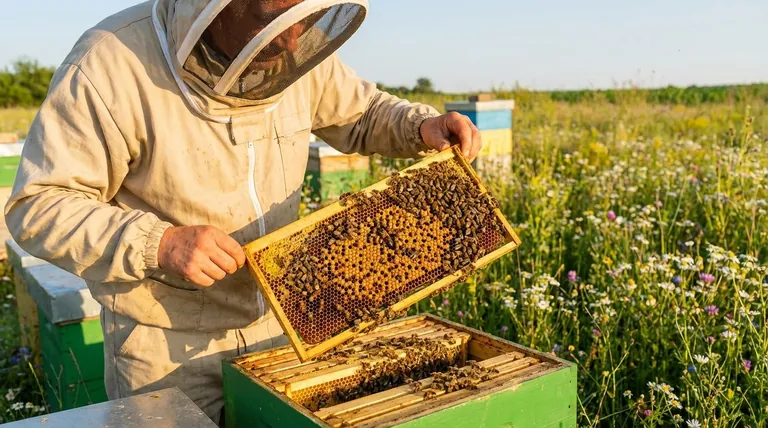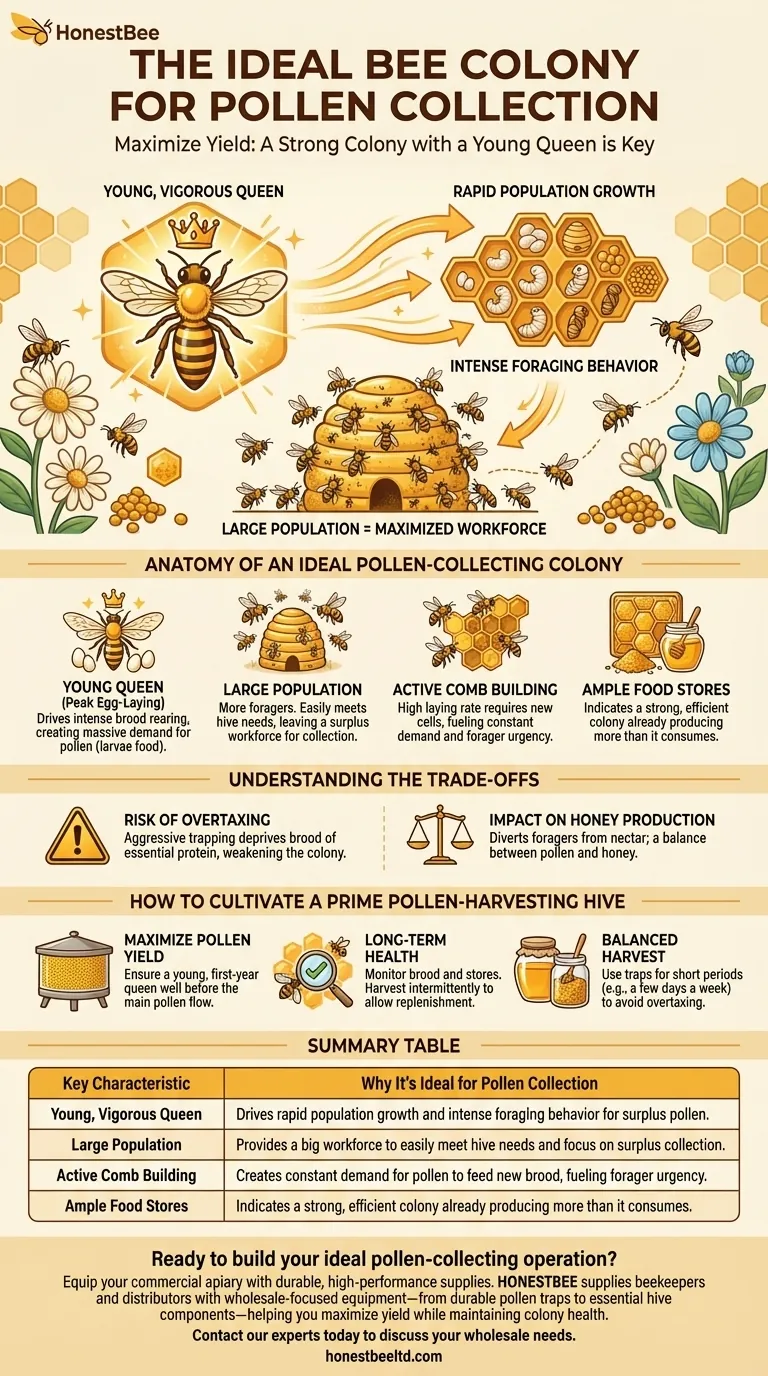To maximize pollen collection, you must select a colony that is both strong and led by a young, vigorous queen. This combination is essential because young queens drive the rapid population growth and industrious behavior required to gather a surplus of pollen beyond the hive's own needs.
The success of your pollen harvest is a direct reflection of the colony's internal health and motivation. The key is understanding that a young queen doesn't just lay more eggs; she orchestrates the entire colony's drive to expand and forage, which is the true engine of surplus pollen collection.

The Anatomy of an Ideal Pollen-Collecting Colony
A hive suitable for pollen harvesting isn't just any hive; it possesses specific characteristics that create the conditions for a surplus. These factors work together in a powerful feedback loop.
The Critical Role of a Young Queen
A young queen is at the peak of her egg-laying capacity. Her high rate of laying stimulates the entire colony to support the rapidly growing brood population.
This intense focus on raising new bees creates a constant and massive demand for pollen, which is the primary protein source for larvae.
The Importance of a Large Population
A direct result of a prolific queen is a large workforce. More bees mean more foragers are available to be dispatched each day.
With a large population, the colony can easily meet its own needs for nectar, water, and pollen, allowing a significant number of foragers to focus on collecting the pollen surplus you intend to harvest.
The Need for Active Comb Building
A young queen's high laying rate requires a constant supply of new cells. This drives workers to build new comb continuously.
This expansion of the brood nest further fuels the demand for pollen, reinforcing the foragers' urgency and efficiency.
Ample Food Stores
A colony that already has significant stores of both honey and pollen is demonstrating its strength and efficiency.
This indicates that the colony is already producing more than it consumes, making it the perfect candidate for harvesting without causing undue stress.
Understanding the Trade-offs
Harvesting pollen is an extractive process, and it's critical to manage it without harming the colony that you depend on.
Risk of Overtaxing the Colony
Pollen is not just a surplus product; it is essential food for the bees' young. Aggressive or prolonged pollen trapping can deprive the brood of necessary protein.
This can lead to a weaker next generation of bees, reduced colony health, and a potential decline in population.
Potential Impact on Honey Production
A bee colony has a finite workforce. By encouraging and trapping pollen, you may be diverting foragers who would have otherwise been collecting nectar.
This can sometimes result in a reduced honey harvest. It is a balancing act between encouraging the collection of two different resources.
How to Cultivate a Prime Pollen-Harvesting Hive
Your management strategy should focus on creating the ideal conditions within the hive before you ever place a pollen trap.
- If your primary focus is maximizing pollen yield: Ensure your colony is headed by a young, first-year queen well before the main pollen flow begins.
- If your primary focus is long-term colony health: Regularly monitor the brood pattern and the pollen stores behind your trap, and only harvest intermittently to allow the bees to replenish their own larder.
- If your primary focus is a balanced harvest of honey and pollen: Use your pollen trap for short periods, such as a few days a week, to avoid committing the entire foraging force to pollen collection alone.
Ultimately, a healthy, thriving colony driven by the powerful biological signals of a young queen is the true engine for any successful pollen harvest.
Summary Table:
| Key Characteristic | Why It's Ideal for Pollen Collection |
|---|---|
| Young, Vigorous Queen | Drives rapid population growth and intense foraging behavior for surplus pollen. |
| Large Population | Provides a big workforce to easily meet hive needs and focus on surplus collection. |
| Active Comb Building | Creates constant demand for pollen to feed new brood, fueling forager urgency. |
| Ample Food Stores | Indicates a strong, efficient colony already producing more than it consumes. |
Ready to build your ideal pollen-collecting operation?
Equip your commercial apiary with the durable, high-performance supplies needed to support strong, productive colonies. HONESTBEE supplies beekeepers and distributors with wholesale-focused equipment—from durable pollen traps to essential hive components—helping you maximize yield while maintaining colony health.
Contact our experts today to discuss your wholesale needs and how our products can help you achieve a superior pollen harvest.
Visual Guide

Related Products
- Professional Long-Handled Silicone Honey Scraper for Beekeeping
- Professional Wide Blade Honey Scraper for Beekeeping and Honey Processing
- Stainless Steel Scraper for Metal Queen Bee Excluders
- Professional Galvanized Hive Strap with Secure Locking Buckle for Beekeeping
- Versatile Ratchet Hive Strap with S-Hooks for Secure Fastening
People Also Ask
- What other tools are available for honey uncapping besides knives? Find the Right Tool for Your Apiary's Scale
- What is honey uncapping? The Essential First Step to Harvest Your Honey
- Can I extract uncapped honey? Avoid spoilage by trusting the bees' quality control.
- Why is it important to remove detached honeycomb pieces? Prevent Pests, Disease, and Robbing
- How much time does it take to do beekeeping? A Realistic Breakdown for Beginners & Pros



















